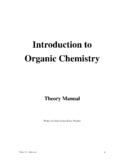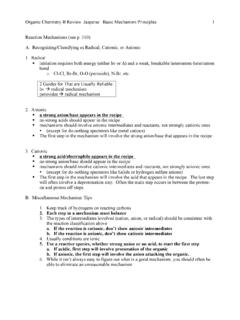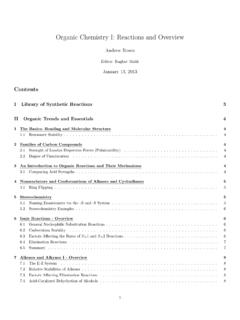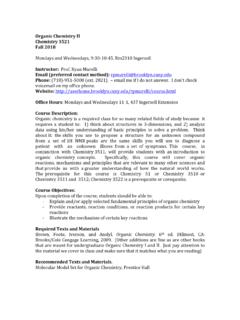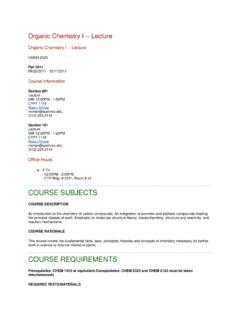Transcription of Organic Chemistry to Biochemistry - sls.downstate.edu
1 Page 1. Metabol isn1. Review: Step by Step from Organic Chemistry to Biochem istry Overview: This handout contains a review of the fundamental parts of Organic Chemistry needed for metabolism. Dr. Richard Feinman Department of Biochemistry Room 7-20, BSB. (718) 270-2252. STEP-BY-STEP: Organic Chemistry TO NUTRITION AND METABOLISM page 2. CHAPTER O. INTRODUCTION. Where we're going. The big picture in nutrition and metabolism is shown in a block diagram or "black box" diagram. A black box approach shows inputs and outputs to a process that may not be understood.
2 It is favored by engineers who are the group that are most uncomfortable with the idea that they don't ----c02 know anything at all. The black box approach can frequently give you some insight because it organizes whatever you do know. For example: ENERGY CELL MA TERIA L 1. Even though the block diagram is very simple, just looking il at the inputs and outputs gives us some useful information. The diagram says animals obtain energy by the oxidation of food to CO 2 and water. Although you knew this before, the diagram highlights the fact that understanding Biochemistry probably involves understanding oxidation-reduction reactions.
3 2. The diagram also indicates what might not be obvious: a major part of the energy obtained from oxidation of food is used to make new cell material. Although we think of organisms using energy for locomotion or to do physical work, in fact, most of the energy used is chemical energy. 3. Inside the black boxes in the diagram contain are the ( Organic ) chemical reactions that convert food into energy and cell material. Biochemistry is the study of these Organic reactions, the structure of the proteins and enzymes (catalysts) that control these processes and the genetic material that specifies which proteins are to be made for each cell and organism.
4 4. The Strategy: 1. We are going to break into the black boxes: Our first intuition from the black box, consistent with our everyday experience, is that food is oxidized, like fuel in a car, to obtain energy. Unlike a car however, which uses one step explosive reactions, biological systems must carry out the reaction in small steps in order to capture the energy in chemical compounds. Metabolism is the step-by-step conversion of food into break-down products for energy (catabolism) and the step-by-step conversion of some food to cell material (anabolism).
5 2. Organic Chemistry . To a large extent, nutrition and metabolism is applied Organic Chemistry . There's more to it than that, but most of it is Organic reactions. The good news is that only a small part of what you learned in Organic Chemistry is critical for understanding Biochemistry . 3. The model reaction and a preview. When ethanol is ingested, the liver converts it to acetaldehyde and then to acetic acid. This sequence, alcohol -~ aldehyde -~ carboxylic acid, are the fir!;;t steps in a larger process which ultimately converts the carbons of ethanol to C02.
6 This is an oxidation {indicated by [0] and, in this sense, ingested alcohol can be burned as a fuel to produce energy for life. This series of reactions is of clear medical importance itself. In addition, it defines the three most important types of compounds you have to know from Organic Chemistry . 5. How To Use This Book: If you are comfortable with these structures -- if you recognize ethanol, acetaldehyde and acetic acid, you can go to directly to Chapter 4. The Big Four: Alcohols, Amines, Carbonyls And Carboxylic Acids.}
7 If you want a more complete review, go to Chapter 1 which starts from scratch. 009. SBS-02 CHAPT. 0 June 27,2002,21:27 2002 Richard D. Feinman STEP-BY-STEP: Organic Chemistry TO NUTRITION AND METABOLISM page 3. 6. Study Methods. 1. Some of the sections in this book are of the "workbook" type and require that you fill in answers. We recommend that you do these and not go on until you are sure that you understand the answers asked for. You may need to look things up in the text. Answers are provided at the end but you will get the most out of this if you try it yourself first.
8 2. It is a good idea to time yourself, especially when studying metabolic pathways or learning the names of compounds like the amino acids. These projects can seem large and daunting. By seeing exactly how long each Chapter takes, you will di~cover that they are less demanding than you thought. Chapters are designed for about a half hour, but even if they take longer, you will know what you are up against. 7. The Importance of Nomenclature. 1 . Chemistry is a language and cannot be used in a loose way. One of the reasons that you study Organic Chemistry is to develop precision in language.
9 Looking ahead, if you prescribe klonopin (anti-convulsant) when you mean c10nidine (anti-hypertensive) you may not get the best result. (That may be why they changed the name of c1onopin to klonopin). The systematic (IUPAC) language is more precise than English because it is more logical. 2. Biochemical compounds were discovered before the IUPAC and so many have common names or sometimes only semi-systematic names. We recommend that, whenever possible, you give an IUPAC name to a compound even if it has a common name.
10 This allows you to get a feel for the nature of the compound. In general, you want to feel that, as much as possible, you are not memorizing things but associating names with properties. So, for example, to identify the name alanine, first calling it 2-amino propanoic acid will help you see it as an amino acid. When you study the way alanine is converted to pyruvic acid and pyruvic acid is converted to lactic acid, recognizing them as 2-amino propanoic, 2-oxo propanoic and 2-hydroxy propanoic will help you see how they are related to each other.

